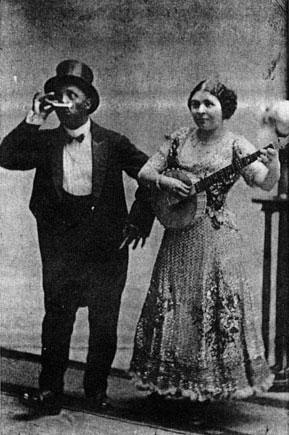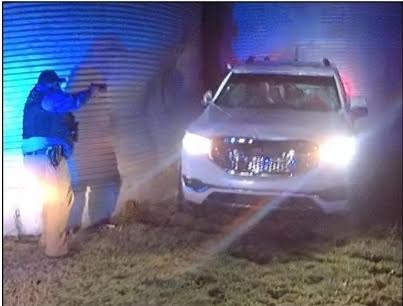Peter G. Hampton
Published 12:00 am Friday, April 2, 2010

- Pete Hampton and Laura Bowman.
Peter G. Hampton was born in 1871 in Bowling Green, Ky. He was a singer, banjo player, lyricist, comedian, dancer and actor. Hampton is considered to be the first African American, possibly even the first person, to be recorded playing a harmonica as well as the first black actor or entertainer to appear in a British film. It is said that he recorded more than any other contemporary African American and was the most recorded American visitor in Europe, black or white, prior to World War I.
As a teen Pete Hampton was a member of a banjo playing vocal quartet and appeared in Medicine Shows throughout Ohio. In the 1890’s he toured with several prominent minstrel troupes including: Al G. Fields’ Darkest Africa-Company, Mahara’s Minstrels, P.T. Wright’s Nashville Students and John W. Isham’s Octoroons.
Trending
By 1900 he had become a member of the Sons of Ham Company and in 1902 he joined the prominent Williams and Walker company’s production of In Dahomey, the comedy teams first hit musical. Hampton played Hamilton Lightfoot, third on the bill in the production. There he met cast member Laura Bowman who had been raised across the river, in Cincinnati. With the two cast players, the production went on to New York and then England in 1903.
Hampton and Bowman toured London where they would settle for a decade. In Dahomey played at Buckingham Palace for the ninth birthday of the Prince of Wales, Edward VII and was the only African-American musical of the period which resulted in a publication of a piano-vocal score. It ran for more than 1100 performances. In the UK the company’s artists were socially accepted and Hampton became a member of the Free Masons Grand Lodge of Scotland.
Most of Hampton’s recordings were made between 1903 and 1911 in Germany and Britain while he toured and lived in Europe. Like many black performers in post slavery America, Hampton found more opportunity in Europe where musicians toured the theatre circuit, often playing in mixed race performances. Hampton and others toured all of Europe, Northern Africa, the Balkans and into Siberia and was also featured in a movie.
Though most of his well over 150 known cylinder and disc recordings of this time have been lost, a wax cylinder of Hampton performing his own composition Dat Mouth Organ Coon still exists and can be heard at www.patmissin.com/78rpm/MouthOrganCoon.mp3. While Hampton is noted for being the first to record with a harmonica, this song is the only known one of his recordings using the instrument.
An earlier version of Dat Mouth Organ Coon for Edison lead Rainer E. Lotz to comment in his presentation before the International Association of Jazz Record collectors (IAJRC), “But the following and a few others have survived, forcing us to re-write the prehistory of jazz.” Author P. Missin also notes the importance of the recording saying “His harp playing cannot be considered blues in the strictest sense of the word, although it does have many elements of the blues in it, including a short fox chase section and a finale which appears to have Hampton playing harp with his nose whilst simultaneously whistling!” This version of the song with an extended harmonica part can be found along with I’m Going To Live Anyhow Until I Die (1904) in the CD accompanying the book Black People, entertainers of African descent in Germany, and Europe by Rainer Lotz.
In Cross the Water Blues, Neil Wynn describes the recording saying, “‘Dat Mouth Organ Coon’ has an interesting ragtime piano introduction, Hampton sings a few stanzas of a typical ragtime song, suddenly he doubles the tempo and the piano accompaniment gets into a frenzy. Right in the middle of the performance Hampton abruptly takes out the tempo. He switches to harmonica, hence the title ‘Dat Mouth Organ Coon,’ and he quotes ‘The Last Rose of Summer’. Hampton’s specialty was playing the harmonica through his nose, but on this cylinder, after stating the melody, he performs at such a break-neck speed, that this is difficult to believe. He bends the melody, he adds blue notes, he produces all sorts of queer sounds that must make Thomas Moore rotate in his Irish grave, and he adds shouts and vocal interjections just like recorded blues singers would do decades later.”
Trending
The other recording on Lotz’s CD, I’m Going To Live Anyhow Until I Die was first made a hit in 1901 by Shepard N. Edmonds, a ragtime composer. His original sheet music for the song contained a dedication to “the unbleached American, Ernest Hogan“. Hogan, a native of Bowling Green, Ky. had introduced the song at the New York Theater Roof Garden. Historian Alan Lomax wrote in 1959 that the song was “one of a family of tunes lying between black square dance music… and the first true instrumental blues.”
Hampton’s recordings range from the minstrel tradition as well as gospel and camp meeting fare. As with many African American musicians of the era, a number of Hampton’s songs were criticized for their negative portrayal of blacks and reinforcement of stereotypes, including: “Dat Phrenologist Coon” (1904), “Dat’s De Way To Spell Chicken” (1905) and Rufus Rastus Johnson Brown (1905).
After the original In Dahomey company broke up, Hampton and Bowman remained in London. Instead of joining the new company when it formed, they created their own Darktown Entertainers quartet (William Garland – tenor, Fred Douglas – bass, Pete Hampton – baritone, Laura Bowman – soprano). The quartet’s repertoire included all types of music from grand opera to lullabies and they toured Germany, Hungary, Austria, France, Switzerland and Russia. By the time they disbanded Hampton and Bowman had been living together long enough to be considered common law husband and wife.
The two returned to America where Bowman played for 32 weeks in the chorus of The Southerns and then went back to London to join the second company of In Dahomey, where Bowman earned a principal part. When In Dahomey closed the two formed a duet and continued to tour Europe and live in England.
In 1907 playbills referred to Hampton and Bowman as the “Down in Kentucky” act, billing them as “colored Character Duettists. By 1908 Bowman was playing the London Hippodrome. In 1909 Pete Hampton appeared on screen for the Warwick Cinephone Films company performing his previously recorded song Hannah! Won’t You Open That Door? in synchronization with a gramophone record. It was one of the earliest experiments in matching film and sound.
Both Hampton and Bowman were great continental successes, all but forgotten in the US. They settled near Wimbledon Park in a house they dubbed Darktown Villa. Laura Bowman’s parents joined them in 1910. But, with the approach of war, foreigners were sent home and Hampton and Bowman returned to America in 1913. Pete Hampton became ill on the journey home and never fully recovered. He died in 1916.
Later that same year the irrepressible Laura Bowman joined the Lafayette Players where she met future husband Sidney Kirkpatrick. Shortly afterward she made her film debut in Oscar “The Father of Afro-American cinema” Micheaux’s The Brute and would become one of his regularly featured actors. She starred in such notable and controversial films as Murder in Harlem (1935) about a black man falsely accused of murdering a white woman and Veiled Aristocrat (1932) about a light-skinned African American whose family opposes her marriage to a dark-skinned man. Both themes were common in Micheaux’s work starting with his 1919 film, Within Our Gates, and indictment of the racism of the day, often cited as a reaction to LaGrange, Ky. born D.W. Griffith’s endorsement of the KKK in Birth of a Nation (1915)
She also established the National Art School in New York. She would continue her career both on stage and screen, recognized for portraying characters beyond the typical Hollywood stereotypes relocated to black actors. From 1923-1925 she was part of the groundbreaking Ethiopian Art Players, playing Herodias in Oscar Wilde’s Salome, Aunt Nancy in Willis Richardson’s The Chip Woman’s Fortune and Aemilia in a jazz version of Shakespeare’s Comedy of Errors. The Chip Woman’s Fortune became to first serious play by a black playwright to be presented on Broadway. During the 30’s she also starred in a string of radio programs. After Krikpatrick’s death she married LeRoi Antoine . In 1940 she played the lead in Son of Ingagi, the first all black horror film. In 1947 she was featured in Anna Lucasta in Los Angeles. The play’s star Ossie Davis recalled “We were the cast that integrated the theatre.” The artists became the toast of the town wined and dined after show by notables such as Charlie Chaplin, Humphrey Bogart, Anthony Quinn and Van Johnson, though the hospitality was not extended to hotel accommodations. She retired in 1950 and suffered a stroke that confined her to a wheelchair until her dealth in 1957. Her New York Times obituary noted “It was said of Miss Bowman that she played in about every country that had a theatre.” In 1961 Antoine published her biography, Achievement: The Life of Laura Bowman as told by Laura Bowman to her husband.
References:
- From Minstrelsy to Jazz: Cross-cultural links between Germans and Afro-Americans. Presentation at the International Association of Jazz Record Collectors (IAJRC) 1999 Convention, Hamburg, Thursday, 29 July 1999 by Rainer E. Lotz – www2.hu-berlin.de/fpm/popscrip/themen/pst08/Lotz.htm
- Who was the first blues harp player to record? (Plus a few other blues harp “firsts”) by P. Missin www.patmissin.com/ffaq/q5.html
- Harlem Renaissance lives from the African American national biography By Henry Louis Gates, Evelyn Brooks Higginbotham
- Black in the British frame: the black experience in British film and television By Stephen Bourne
- Black women in America: an historical encyclopedia, Volume 1 By Darlene Clark Hine, Elsa Barkley Brown
- Ragged but right: black traveling shows, “coon songs,” and the dark pathway By Lynn Abbott, Doug Seroff
- Historical dictionary of African American theater By Anthony D. Hill, Douglas Q. Barnett
- Black Edwardians: Black people in Britain, 1901-1914 By Jeffrey P. Green
- Bright Boulevards, Bold Dreams: The Story of Black Hollywood By Donald Bogle
- Cross the water blues: African American music in Europe By Neil A. Wynn






